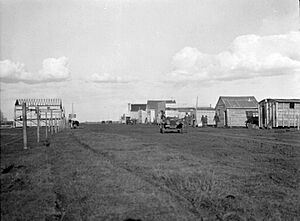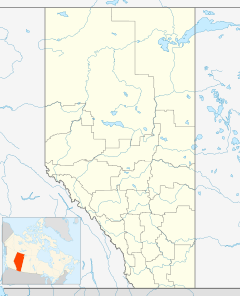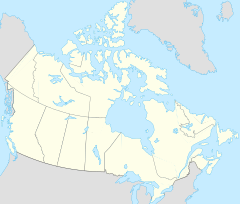Waterhole, Alberta facts for kids
Quick facts for kids
Waterhole
|
|
|---|---|
|
Unincorporated locality
|
|

Waterhole, 1920
|
|
| Country | Canada |
| Province | Alberta |
| Municipal district | Fairview No. 136 |
| Time zone | UTC−7 (MST) |
| • Summer (DST) | UTC−6 (MDT) |
| GNBC Code | IAOZM |
Waterhole is a place in Alberta, Canada. It's part of the Municipal District of Fairview No. 136. Today, it's a ghost town, which means most people have left and few buildings remain. But in the early 1900s, Waterhole was a busy and successful community.
Contents
Waterhole's Early Days
In the late 1800s, this spot was called "The Waterhole." It got its name because people could find clean drinking water from Boucher Creek there. The first person to settle in Waterhole arrived in 1908.
By 1912, Waterhole had its own post office, where people could send and receive mail. A general store opened in 1914, selling all sorts of goods. That same year, the community started an annual agricultural fair, celebrating local farming. Waterhole had more than 50 residents by then.
Growing Community Services
Waterhole continued to grow. In 1916, a community hall was built for meetings and events. By 1926, the town was thriving. It had a doctor's office, a livery barn (where horses were kept and rented), and a blacksmith shop. There was also a hardware store, a bank, and a telegraph office for sending messages. The town even had its own electrical generator and telephone service.
The Empire Hotel in Waterhole was owned by three Chinese immigrants. Waterhole became a very important place for business and social activities. It was a central hub between the towns of Peace River and Dunvegan.
Why Waterhole Became a Ghost Town
Waterhole's success didn't last forever. In 1928, a new railway, the Edmonton, Dunvegan and British Columbia Railway, was built through the area. However, it didn't go through Waterhole. Instead, it was built about 6 kilometres (3.7 miles) north, through the town of Fairview.
Moving to Fairview
Being near a railway was very important for towns back then. It meant easier ways to transport goods and people, which brought more business and growth. To benefit from this, most of the families and businesses in Waterhole decided to move to Fairview.
The people from Waterhole were given the first choice of land lots for sale in Fairview. Some buildings from Waterhole were moved whole to Fairview. Others were taken apart and then rebuilt in the new town. This helped Fairview grow into a regional center for the surrounding farms.
Waterhole's End
The post office in Waterhole closed in 1932. After that, Waterhole was mostly abandoned. Few buildings remained, and much of the old town site was plowed over for farming. The Waterhole Cemetery is still used today. In 1990, archaeologists studied the area to learn more about Waterhole's past.
Notable People
- Donald MacBeth Kennedy was a Member of Parliament, which means he was elected to represent the people of his area in the Canadian government.



